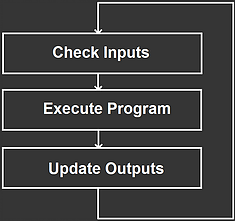What is a PLC?
A PLC (Programmable Logic Controller) is a device that was invented to replace the necessary sequential relay circuits for machine control back in the 70s. The “programmable” term means that PLCs can receive instructions (programs) from the user to perform the desired actions. Today, PLCs are everywhere, inside and outside industry. Almost any application that needs some type of electrical control has a need for a PLC.
OpenPLC is the first and only PLC to be completely free and open source. That means that you can start experimenting with PLCs today with basically no cost to you. All you need is a computer and a cheap hardware board (although you can still work without a hardware board, but that’s no fun).
Any PLC mainly consists of a CPU, memory areas (called address space in OpenPLC) and input/output circuits. Internally, a PLC works by continually scanning a program. This scan cycle consists of 3 important steps: check inputs, execute program, and update outputs.

All a PLC will do in its whole life is execute those three steps. On the first step it takes a look at each input and saves that information. After that, the PLC executes your program, one instruction at a time. Based on your program and on the inputs read in the previous step, the PLC will take decisions upon the state of the outputs (if an output should turn on or off for example). The final step is to update the outputs according to the calculated states from the previous step. This is when your output will finally turn on or off based on your program and on the inputs.
Now that you know what a PLC is and how it works, you’re probably ready to dive-in to the most exciting part: programming your OpenPLC. The next steps on the Reference material will guide you towards understanding Ladder Logic (LD), the fundamental PLC language.
However, OpenPLC not only understands LD, but also four other languages that you can use concurrently on your program:
- Instruction List (IL)
- Function Block Diagram (FBD)
- Sequential Function Chart (SFC)
- and Structured Text (ST).
After you learn LD, it will be easier to learn the other languages and explore their full potential.